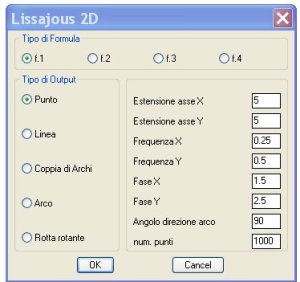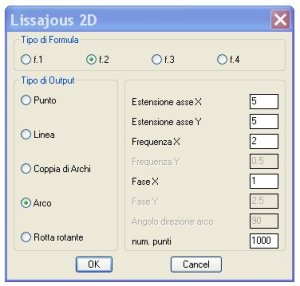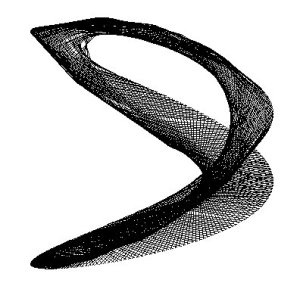 |
Lisp »Tips 'n Tricks
»Lisp & Lissajous
»1
»2
»3
»4
»5
»6
»7

Il lisp LISAJU2 disegna curve di Lissajous bidimensionali sulla base di 4 formule diverse e il riquadro di dialogo mostra molte caselle da editare, ma solo 2 formule necessitano di tutti i dati presenti nel riquadro di dialogo; inoltre è inutile cambiare l'angolo nella casella 'Angolo direzione arco' se l'output è un insieme di punti, di linee o di singoli archi.
| Descrizione |
Nome della variabile |
Formula 1 |
Formula 2 |
Formula 3 |
Formula 4 |
| Estensione asse X |
xL |
+ |
+ |
+ |
+ |
| Estensione asse Y |
yH |
+ |
+ |
+ |
+ |
| Frequenza X |
xF |
+ |
+ |
+ |
+ |
| Frequenza Y |
yF |
+ |
- |
- |
+ |
| Fase X |
xPh |
+ |
+ |
+ |
+ |
| Fase Y |
yPh |
+ |
- |
- |
+ |
Quindi il passo successivo è inserire nel sorgente lisp una funzione che non consente all'utente di digitare nel riquadro di dialogo un dato superfluo.
La funzione è (mode_tile var 0/1).
E' inutile passare alla funzione mode_tile tutte le variabili elencate nella tabella, passeremo solo quelle con il segno - e cioè yF e yPh.
Le modifiche nel codice sorgente sono in colore blu.
LISAJU2.DCL
/*
LISAJU2.DCL (vers. 2.3)
Copyright (C) 2005 Claudio Piccini.
All rights reserved
www.cg-cad.com
*/
dcl_settings : default_dcl_settings { audit_level = 1; }
lisaju2 : dialog {
label = "Lissajous 2D";
: boxed_radio_row {
label = "Tipo di Formula";
: radio_button {
label = "f.1";
key = "f1";
value= "1";
}
: radio_button {
label = "f.2";
key = "f2";
}
: radio_button {
label = "f.3";
key = "f3";
}
: radio_button {
label = "f.4";
key = "f4";
}
}
: row {
: boxed_radio_column {
label = "Tipo di Output";
: radio_button {
label = "Punto";
key = "o1";
value= "1";
}
: radio_button {
label = "Linea";
key = "o2";
}
: radio_button {
label = "Coppia di Archi";
key = "o3";
}
: radio_button {
label = "Arco";
key = "o4";
}
: radio_button {
label = "Rotta rotante";
key = "o5";
}
}
: column {
: boxed_column {
: row {
: edit_box {
label = "Estensione asse X";
key = "xL";
edit_width = 4;
}
}
: row {
: edit_box {
label = "Estensione asse Y";
key = "yH";
edit_width = 4;
}
}
: row {
: edit_box {
label = "Frequenza X";
key = "xF";
edit_width = 4;
}
}
: row {
: edit_box {
label = "Frequenza Y";
key = "yF";
edit_width = 4;
}
}
: row {
: edit_box {
label = "Fase X";
key = "xPh";
edit_width = 4;
}
}
: row {
: edit_box {
label = "Fase Y";
key = "yPh";
edit_width = 4;
}
}
: row {
: edit_box {
label = "Angolo direzione arco";
key = "ang";
edit_width = 4;
}
}
: row {
: edit_box {
label = "num. punti";
key = "steps";
edit_width = 4;
}
}
}
}
}
: row {
: spacer { width = 1; }
: button {
label = "OK";
is_default = true;
key = "accept";
width = 8;
fixed_width = true;
}
: button {
label = "Cancel";
is_cancel = true;
key = "cancel";
width = 8;
fixed_width = true;
}
: spacer { width = 1; }
}
}
//eof
|
LISAJU2.LSP
;|
LISAJU2.LSP (vers. 2.3)
Copyright (C) 2005 Claudio Piccini.
All rights reserved
www.cg-cad.com
Generatore di curve di Lissajous 2D
Formula 1:
x = xL*sin(xF*e+xPh)
y = yH*sin(yF*e+yPh)
Formula 2:
x = xL*sin(xF*e+xPh)
y = yH*sin(e)
Formula 3:
x = x+(xL*sin(xF*e+xPh))
y = y+(yH*sin(e))
Formula 4:
x = xL*sin(xF*e)*cos(xPh*e)
y = yH*sin(yF*e)*sin(yPh*e)
Output: punto,linea,2 archi,arco.
Il metodo dei 2 archi e' basato su:
C.A. Pickover, "La matematica di Oz"
(n.84 "L'overdrive della strega")
Franco Muzzio Editore (2004)
|;
(defun myerror (s)
(if (/= s "Function cancelled")
(princ (strcat "\nError: " s))
)
(ripVar)
(princ)
)
(defun salVar ()
(setq orto (getvar "orthomode"))
(setq snapp (getvar "osmode"))
(setq snm (getvar "snapmode"))
(setq piano (getvar "clayer"))
)
(defun ripVar ()
(command "_redraw")
(setvar "cmdecho" 1)
(setvar "osmode" snapp)
(setvar "snapmode" snm)
(setvar "orthomode" orto)
(setvar "clayer" piano)
(setq *error* olderr)
(princ)
)
(defun ripGlo ()
(setq #05ls1 xL) ; parametro reale xL (est. asse X)
(setq #05ls2 yH) ; parametro reale yH (est. asse Y)
(setq #05ls3 xF) ; parametro reale xF (frequenza X)
(setq #05ls4 yF) ; parametro reale yF (frequenza Y)
(setq #05ls5 xPh) ; parametro reale xPh (fase X)
(setq #05ls6 yPh) ; parametro reale yPh (fase Y)
(setq #05ls7 steps) ; parametro intero steps (numero punti)
(setq #05ls8 ang) ; parametro intero ang (direzione arco)
)
(defun defaults ()
(setq xL #05ls1)
(setq yH #05ls2)
(setq xF #05ls3)
(setq yF #05ls4)
(setq xPh #05ls5)
(setq yPh #05ls6)
(setq steps #05ls7)
(setq ang #05ls8)
(set_tile "xL" (rtos 0.00 2))
(set_tile "yH" (rtos 0.00 2))
(set_tile "xF" (rtos 0.00 2))
(set_tile "yF" (rtos 0.00 2))
(set_tile "xPh" (rtos 0.00 2))
(set_tile "yPh" (rtos 0.00 2))
(set_tile "steps" (rtos 0 2))
(set_tile "ang" (rtos 0 2))
(setq #05ls1 (rtos #05ls1 2 2))
(setq #05ls2 (rtos #05ls2 2 2))
(setq #05ls3 (rtos #05ls3 2 2))
(setq #05ls4 (rtos #05ls4 2 2))
(setq #05ls5 (rtos #05ls5 2 2))
(setq #05ls6 (rtos #05ls6 2 2))
(setq #05ls7 (rtos #05ls7 2 0))
(setq #05ls8 (rtos #05ls8 2 0))
(set_tile "xL" #05ls1)
(set_tile "yH" #05ls2)
(set_tile "xF" #05ls3)
(set_tile "yF" #05ls4)
(set_tile "xPh" #05ls5)
(set_tile "yPh" #05ls6)
(set_tile "steps" #05ls7)
(set_tile "ang" #05ls8)
(setq formula 1) ; tipo di formula
(cond
((= formula 1)(set_tile "f1" "1"))
((= formula 2)(set_tile "f2" "1"))
((= formula 3)(set_tile "f3" "1"))
((= formula 4)(set_tile "f4" "1"))
)
(setq outp 3) ; tipo di output (punti,linee,archi)
(cond
((= outp 1)(set_tile "o1" "1")) ; punto
((= outp 2)(set_tile "o2" "1")) ; linea
((= outp 3)(set_tile "o3" "1")) ; coppia di archi
((= outp 4)(set_tile "o4" "1")) ; arco
((= outp 5)(set_tile "o5" "1")) ; rotta rotante
)
)
(defun do_xL () (setq xL (atof (get_tile "xL"))))
(defun do_yH () (setq yH (atof (get_tile "yH"))))
(defun do_xF () (setq xF (atof (get_tile "xF"))))
(defun do_yF () (setq yF (atof (get_tile "yF"))))
(defun do_xPh () (setq xPh (atof (get_tile "xPh"))))
(defun do_yPh () (setq yPh (atof (get_tile "yPh"))))
(defun do_Steps () (setq steps (atoi (get_tile "steps"))))
(defun do_Ang () (setq ang (atoi (get_tile "ang"))))
(defun lissajous2 ( x y i / e xx yy
p1 p2 p3 p4
a1 a2
)
(if (< i steps)
(progn
;
; tipo di formula
;
(cond
((= formula 1)
(setq e (* 1.0 i))
(setq xx (* xL (sin (+ (* xF e) xPh))))
(setq yy (* yH (sin (+ (* yF e) yPh))))
)
((= formula 2)
(setq e (+ (* 1.0 i)(/ 1.0 steps)))
(setq xx (* xL (sin (+ (* xF e) xPh))))
(setq yy (* yH (sin e)))
)
((= formula 3)
(setq e (+ (* 1.0 i)(/ 1.0 steps)))
(setq xx (+ x (* xL (sin (+ (* xF e) xPh)))))
(setq yy (+ y (* yH (sin e))))
)
((= formula 4)
(setq e (/ (* 4 pi i) steps))
(setq xx (* xL (sin (* xF e))(cos (* xPh e))))
(setq yy (* yH (sin (* yF e))(sin (* yPh e))))
)
)
;
; tipo di output
;
(cond
((= outp 1) ; punto
(command "_point" (list (+ xx (car pStart))(+ yy (cadr pStart))))
)
((= outp 2) ; linea
(if (> i 0)
(command "_line"
(list (+ x (car pStart))(+ y (cadr pStart)))
(list (+ xx (car pStart))(+ yy (cadr pStart)))
""
)
(command "_point" (list (+ xx (car pStart))(+ yy (cadr pStart))))
)
(setq x xx)
(setq y yy)
)
((= outp 3) ; coppia di archi (modo Inizio,Fine,Direzione)
(if (> i 0)
(progn
(setq p1 (list (+ x (car pStart))(+ y (cadr pStart)))) ; Inizio
(setq p2 (list (+ xx (car pStart))(+ yy (cadr pStart)))) ; Fine
(setq a1 (angle p1 p2))
(if (OR (= (/ ang 180.0) 1)(= (/ ang 180.0) 2))
(progn
(setq a2 (* pi 0.0174533)) ; 1 grado
(setq p3 (polar p1 (+ a1 a2) 0.1))
(setq p4 (polar p1 (- a1 a2) 0.1))
(command "_arc" p1 "_e" p2 "_d" p3)
(command "_arc" p1 "_e" p2 "_d" p4)
)
(progn
(setq a2 (* pi (/ ang 180.0)))
(setq p3 (polar p1 (+ a1 a2) 0.1))
(setq p4 (polar p1 (- a1 a2) 0.1))
(command "_arc" p1 "_e" p2 "_d" p3)
(command "_arc" p1 "_e" p2 "_d" p4)
)
)
)
(command "_point" (list (+ xx (car pStart))(+ yy (cadr pStart))))
)
(setq x xx)
(setq y yy)
)
((= outp 4) ; arco (modo Inizio,Fine,Raggio)
(if (> i 0)
(progn
(if (= test 0) ; disegna l'arco a steps alterni
(progn
(setq p1 (list (+ x (car pStart))(+ y (cadr pStart)))) ; Inizio
(setq p2 (list (+ xx (car pStart))(+ yy (cadr pStart)))) ; Fine
(command "_arc" p1 "_e" p2 "_r" p1)
(setq test 1)
)
(setq test 0)
)
)
(command "_point" (list (+ xx (car pStart))(+ yy (cadr pStart))))
)
(setq x xx)
(setq y yy)
)
((= outp 5) ; rotta rotante
; coppia di archi (modo Inizio,Fine,Direzione)
(if (> i 0)
(progn
(setq p1 (list (+ x (car pStart))(+ y (cadr pStart)))) ; Inizio
(setq p2 (list (+ xx (car pStart))(+ yy (cadr pStart)))) ; Fine
(setq angolo (+ angolo 10))
(if (> angolo 360)(setq angolo 10))
(setq angolo (* pi (/ angolo 180.0))) ; radianti
(setq p2 (polar p2 angolo 1)) ; nuovo punto finale
(setq a1 (angle p1 p2))
(if (OR (= (/ ang 180.0) 1)(= (/ ang 180.0) 2))
(progn
(setq a2 (* pi 0.0174533)) ; 1 grado
(setq p3 (polar p1 (+ a1 a2) 0.1))
(setq p4 (polar p1 (- a1 a2) 0.1))
(command "_arc" p1 "_e" p2 "_d" p3)
(command "_arc" p1 "_e" p2 "_d" p4)
)
(progn
(setq a2 (* pi (/ ang 180.0)))
(setq p3 (polar p1 (+ a1 a2) 0.1))
(setq p4 (polar p1 (- a1 a2) 0.1))
(command "_arc" p1 "_e" p2 "_d" p3)
(command "_arc" p1 "_e" p2 "_d" p4)
)
)
)
(command "_point" (list (+ xx (car pStart))(+ yy (cadr pStart))))
)
(setq x xx)
(setq y yy)
)
)
(lissajous2 x y (+ i 1))
)
)
)
(defun c:lisaju2 (/ olderr snapp snm orto piano
dcl_id ok_c
outp steps ang angolo
xL yH xF yF xPh yPh
pStart test
)
(setq olderr *error* *error* myerror)
(setvar "cmdecho" 0)
(salVar)
(command "_osnap" "_non")
;
; Variabili globali:
; #05ls1 #05ls2 #05ls3 #05ls4
; #05ls5 #05ls6 #05ls7 #05ls8
;
(if (= #05ls1 nil)(setq #05ls1 5.0)) ; xL
(if (= #05ls2 nil)(setq #05ls2 5.0)) ; yH
(if (= #05ls3 nil)(setq #05ls3 0.25)) ; xF
(if (= #05ls4 nil)(setq #05ls4 0.5)) ; yF
(if (= #05ls5 nil)(setq #05ls5 1.5)) ; xPh
(if (= #05ls6 nil)(setq #05ls6 2.5)) ; yPh
(if (= #05ls7 nil)(setq #05ls7 1000)) ; numero di punti
(if (= #05ls8 nil)(setq #05ls8 90)) ; direzione arco (gradi)
(setq ok_c 1)
(if (< (setq dcl_id (load_dialog "c:/pick/lisp/lisaju2.dcl")) 0)
(exit)
)
(if (not (new_dialog "lisaju2" dcl_id))
(exit)
)
(defaults)
(action_tile "f1" "(setq formula 1)(mode_tile \"yF\" 0)(mode_tile \"yPh\" 0)")
(action_tile "f2" "(setq formula 2)(mode_tile \"yF\" 1)(mode_tile \"yPh\" 1)")
(action_tile "f3" "(setq formula 3)(mode_tile \"yF\" 1)(mode_tile \"yPh\" 1)")
(action_tile "f4" "(setq formula 4)(mode_tile \"yF\" 0)(mode_tile \"yPh\" 0)")
(action_tile "o1" "(setq outp 1)(mode_tile \"ang\" 1)") ; punto
(action_tile "o2" "(setq outp 2)(mode_tile \"ang\" 1)") ; linea
(action_tile "o3" "(setq outp 3)(mode_tile \"ang\" 0)") ; coppia di archi
(action_tile "o4" "(setq outp 4)(mode_tile \"ang\" 1)") ; arco
(action_tile "o5" "(setq outp 5)(mode_tile \"ang\" 0)") ; rotta rotante
(action_tile "xL" "(do_xL)")
(action_tile "yH" "(do_yH)")
(action_tile "xF" "(do_xF)")
(action_tile "yF" "(do_yF)")
(action_tile "xPh" "(do_xPh)")
(action_tile "yPh" "(do_yPh)")
(action_tile "steps" "(do_Steps)")
(action_tile "ang" "(do_Ang)")
(action_tile "accept" "(done_dialog)")
(action_tile "cancel" "(setq ok_c 0)")
(start_dialog)
(unload_dialog dcl_id)
(if (= 1 ok_c)
(progn
(ripGlo)
(setq pStart (getpoint "\n seleziona un punto nel disegno..."))
(setq test 0)
(setq angolo 0) ; rotta rotante
(lissajous2 0 0 0)
(ripVar)
)
(progn
; valori globali di default
(setq #05ls1 5.0) ; xL
(setq #05ls2 5.0) ; yH
(setq #05ls3 0.25) ; xF
(setq #05ls4 0.5) ; yF
(setq #05ls5 1.5) ; xPh
(setq #05ls6 2.5) ; yPh
(setq #05ls7 1000) ; numero di punti
(setq #05ls8 90) ; angolo direzione arco
(ripVar)
)
)
)
;;;eof
|


Lisp »Tips 'n Tricks
Ultimo Aggiornamento_Last Update: 24 Maggio 2005
|
 |

